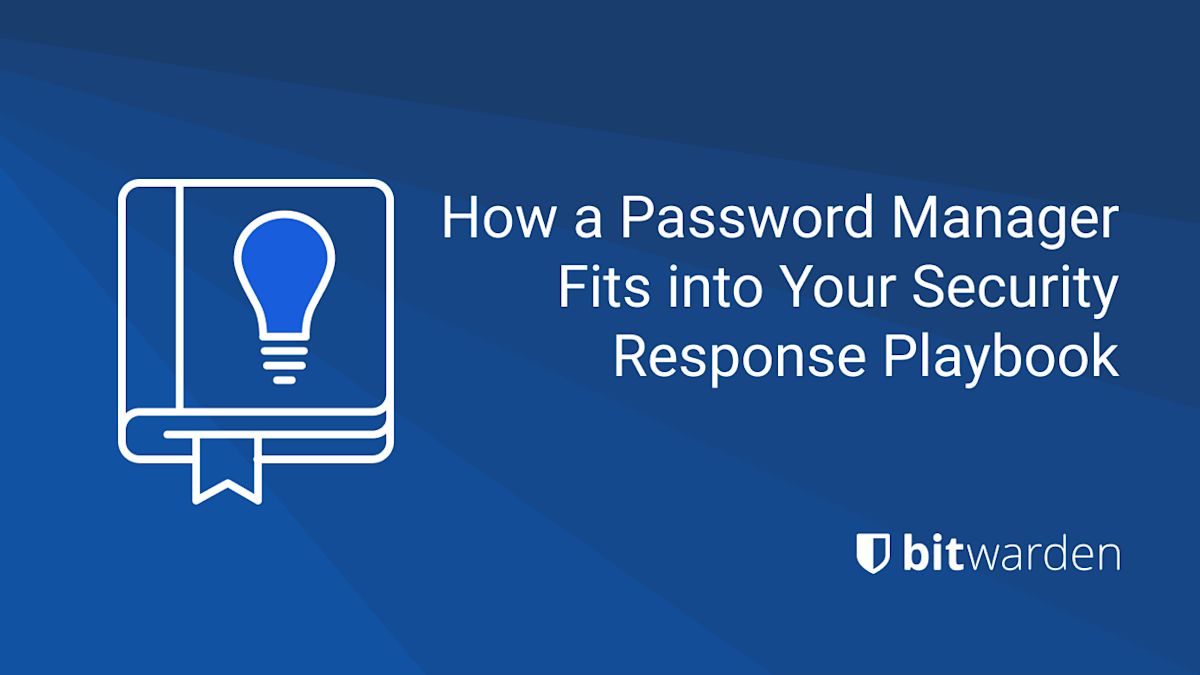- Blog
- How a Password Manager Fits into Your Security Response Playbook
Security response playbooks form the backbone of an organization’s cybersecurity incident response plan (CSIRP) and ensure consistency in managing security incidents and threats. For organizations with formal, enterprise-wide CSIRPs, incident-specific playbooks can reduce the impact of a cyberattack and thereby reduce business disruption.
Password management can play a critical role, bridging an often ignored gap between policies and procedures. This blog explores how organizations can incorporate password management into their incident response plans in a scalable way.
What is a Security Response Playbook?
Security response playbooks are step-by-step workflows and operating procedures for cyber incidents such as malware, ransomware, phishing, or DDoS attacks). The workflows include steps to ensure compliance with regulatory frameworks.
The five steps to incident response and the role of a password manager
As there is no one-size-fits-all security response playbook, they are often customized to the organization’s size, strategies, structure, existing tools, and available skills. However, most playbooks have a similar five-step format to ensure security teams respond to cyber incidents in a coordinated manner. Here’s what those steps look like and how a password manager contributes during each stage.
Preparation
Organizations should establish policies and procedures for incident response management, define which communication channels to use for each type of incident, and assess their current threat detection capability – updating risk assessments and improvement programs where necessary.
The role of a password manager: A password manager empowers a culture of cybersecurity which mitigates the risk of a cyberattack. Furthermore, security teams can run reports to identify weak, reused, or compromised passwords before hacked login credentials result in a cyber incident. Check out some of the reports available in Bitwarden.
Detection and reporting
Detection and reporting involve implementing mechanisms for monitoring activity, detecting potential security incidents, and correlating alerts via a Security Information and Event Management (SIEM) monitoring system. Organizations should establish processes for classifying an incident and escalating reports to the appropriate team(s).
The role of a password manager: The good behaviors that evolve from using a password manager at work facilitate greater awareness of cyber threats, the ability to identify them, and a judgment-free environment for users to admit mistakes such as accidentally clicking on a phishing email.
>>YOU MIGHT ALSO LIKE: Why Employees are the Front Line of Enterprise Threat Prevention
Triage and analysis
Organizations can triage and analyze reports of security incidents in many ways depending on the nature of the incident, such as binary or endpoint analysis. It’s important to scope and understand the incident to support containment and neutralization.
The role of a password manager: Many password managers have SIEM integration capabilities and can feed access data into the event management tool for more accurate triaging and analysis. Password manager integration can also result in intelligible tips about unusual inside activity.
Containment and neutralization
The nature of a security incident and its scope determine an organization’s measures to contain and neutralize a threat. These include a coordinated shutdown, wipe and rebuild, password changes, and blocking egress channels leveraged by cybercriminals for command and control.
The role of a password manager: In some cases, multiple users share login credentials for an account which can cause significant damage if that account gets compromised. Using Collections and user roles help to minimize potential damage as you can assign the appropriate users to specific shared credentials and remove users or credentials from the password manager for the compromised account to prevent another user from accessing.
Post-incident activity
Security response playbooks enable security teams to document what actions were taken, how long it took to respond, and obstacles encountered along the way. This documentation helps determine which steps were successful and which need improvements so teams can better respond to future incidents.
The role of a password manager: Event logs represent one of the most valuable pieces of documentation a security team will use in post-incident analyses. Password managers such as Bitwarden maintain timestamped event logs for around forty different types of events that can be easily accessed and exported for analysis.
Complement your security response playbooks with Bitwarden
Better threat intelligence improves cyber resiliency. Organizations can detect, contain, and respond to threats faster, accelerate the timeline of incident response, and reduce the cost of detecting and preventing data breaches – thus minimizing business disruption.
Bitwarden supports enterprise cyber resilience by contributing to the five incident response steps. Bitwarden also empowers employees to take responsibility for credential security both in their personal and business lives. Try Bitwarden yourself by starting a 7-day Enterprise free trial.
